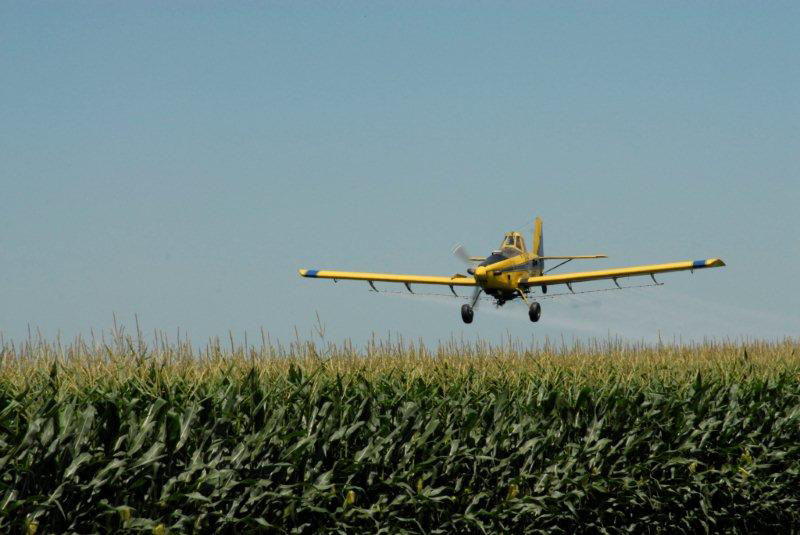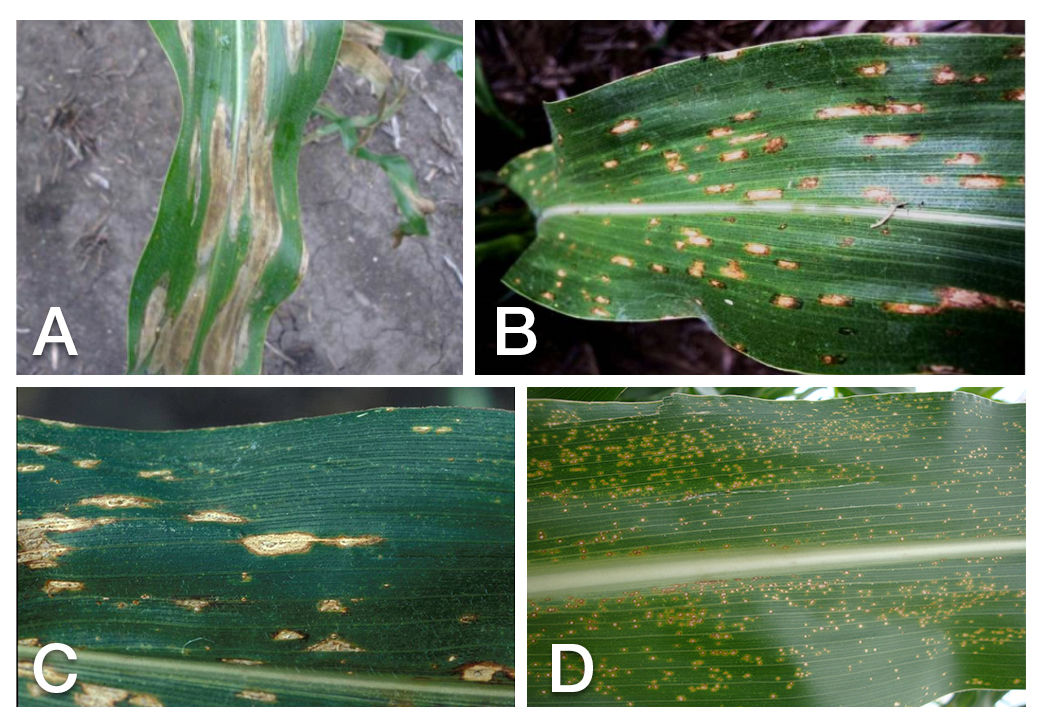Do foliar diseases impact corn stalk health?
July 11, 2023
- Foliar diseases such as tar spot, northern corn leaf blight (NCLB), gray leaf spot (GLS), Anthracnose top die back, and Goss’s wilt can impact stalk quality and health.
- The degree to which a foliar disease impacts stalk quality is dependent on when the disease occurs in relation to plant development; the earlier the disease occurs, the higher the likelihood of an impact on the stalk.
- Other factors including nutrient deficiency, drought, plant population, and insect injury can interact with the foliar disease to increase the chance of reducing stalk quality.

What is the impact of foliar diseases in corn on overall plant health?
Yield loss can occur when the top 8 to 9 leaves above the ear are infected with a foliar disease, because these leaves produce over 70% of the carbohydrates required by the ear.1 Diseases and other stress factors can also reduce the photosynthetic capacity of corn plants during the critical period of grain filling.2 Decreasing the photosynthetic capacity of leaves after tasseling can reduce kernel survival and kernel weight. In addition, when the photosynthetic capacity of the plant is reduced, kernel demand for photosynthates can increase remobilization of stored carbohydrates from stalk and leaf tissues. Stalks can be weakened by this process, increasing plant susceptibility to stalk and root rots. If a combination of multiple stress factors mentioned above occurs during grain fill, these factors can have a substantial impact on corn yield potential.
What environmental conditions favor foliar disease development in corn?
The most common conditions for foliar disease development in corn are warm and humid weather or cool and overcast weather, with extended periods of dew or free-standing moisture on the leaves, and crop residue, which itself may contain pathogen inoculum. Northern corn leaf blight infection occurs at temperatures between 66° and 80° F (19° and 26.5° C), when accompanied by extended periods of wetness from frequent rainfall.3 Gray leaf spot infection occurs during prolonged warm and humid periods, with temperatures of 75° to 85° F (24° to 29° C) and more than 90% relative humidity.4 Symptoms of foliar diseases are commonly observed following long periods of heavy dew and overcast days in bottomlands, or in fields adjacent to woods where humidity is higher and dew persists longer into the morning.
When should scouting begin for foliar diseases in corn?
Begin scouting fields for foliar disease symptoms just before tasseling and continue scouting through the grain-filling growth stages. Rapid grain filling occurs from R2 growth stage (blister) to late R5 growth stage (full dent). Throughout a field, examine the ear leaf and leaves above and below the ear at several locations. If disease symptoms are present on most of the leaves, a fungicide application may be necessary. Fungicide applications can help prevent new infections and disease spread, but they do not cure established infections. Identification of foliar diseases can help determine the need for changes in management practices such as tillage, crop rotation, and corn product selection. Selecting more resistant corn products may help reduce the incidence of disease next season.

When should fungicide applications be made to corn?
Thresholds for fungicide use for NCLB do not exist; however, it is important to protect the ear leaf and those above it as corn plants enter the reproductive stages of growth. Consider using a fungicide on corn products that are susceptible to NCLB or GLS if disease symptoms are present on the 3rd leaf below the ear or on higher leaves on 50% of the plants examined.5 In most cases, fungicide applications should be applied at or after tasseling. Fungicides applied from tasseling to brown silk tend to have the best possibility for economic return. Do not use adjuvants if an application will be made prior to the VT stage of growth (tasseling).6 Follow all individual product label instructions for proper application timing, application volume, application equipment, and environmental and harvest interval precautions.
Should an early-season fungicide application be considered at the V5 to V7 growth stages?
There are many factors to consider when determining if a fungicide application is warranted. In general, most research has found the greatest yield benefit from fungicide applications at the VT to R1 growth stages. The main challenge with most yield-limiting foliar diseases is that they do not become problematic until the reproductive stages of corn development, so it is difficult to determine if an early-season fungicide application is needed. However, the more risk factors at play in a field, the greater the benefit that fungicide applications are likely to provide.
Before making an early-season application, consider what risk factors are present. Risk factors include the continuous use of a field for corn growth, no-till management, recent weather conditions, and diseases already found during scouting. Finally, check the weather forecast to evaluate if upcoming conditions will continue to promote disease development. If only one fungicide application can be made, the VT to R1 growth stage timing typically provides the greatest yield benefit and highest return on investment.7
Prior to making an application, evaluate each field for the susceptibility of the corn product to the diseases, the current yield potential of each field, disease severity, and the corn stage of development. It is important to note that susceptible corn products are more likely to show a favorable response to fungicide applications than corn products with some disease resistance. The fungicide used should be chosen based on its effectiveness for the specific disease present.
Future Considerations
Identification of foliar diseases can help determine the need for changes in management practices such as tillage, crop rotation, and corn product selection. Selecting more resistant corn products may help reduce the incidence of disease next season.
Sources:
1Rees, J.M. and Jackson, T.A. 2008. Gray leaf spot of corn. G1902. University of Nebraska. https://extensionpublications.unl.edu/assets/html/g1902/build/g1902.htm
2Nielsen, R.L (Bob). 2021. Stress during grain fill: A harbinger of stalk health problems. Corny News Network. Purdue University. https://www.agry.purdue.edu/ext/corn/news/timeless/stalkhealth.html
3Wise, K. Northern corn leaf blight. Diseases of Corn. Purdue Extension. Purdue University. BP-84-W. https://www.extension.purdue.edu/extmedia/BP/BP-84-W.pdf
4Wise, K. Gray leaf spot. Diseases of Corn. Purdue Extension. Purdue University. BP-56-W. https://www.extension.purdue.edu/extmedia/bp/BP-56-W.pdf
5Bradley, C.A., Esker, P.D., Paul, P.A., and Robertson, A.E. 2010. Foliar fungicides for corn: targeting disease. University of Illinois, University of Wisconsin, Ohio State University, and Iowa State University. https://store.extension.iastate.edu/product/13403/.
6Stetzel, N., Wise, K., Nielsen, B., and Gerber, C. 2011. Arrested ear development in hybrid corn. Diseases of Corn. Purdue Extension. Purdue University. BP-85-W. https://www.extension.purdue.edu/extmedia/BP/BP-85-W.pdf
7Wise, K.A., Smith, D., Freije, A., et al. 2019. Meta-analysis of yield response of foliar fungicide-treated hybrid corn in United States and Ontario, Canada. PLOS ONE. https://journals.plos.org/plosone/article?id=10.1371/journal.pone.0217510
1211_144949
You may also like...
Here are some articles that may also be of interest to you